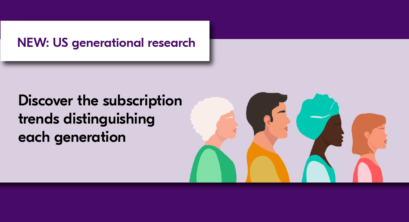Generation gap: How different age groups approach subscription services
by Giles Tongue | 05 Sep 2024

If there’s one thing that Gen Z, Millennials, Gen X, and Boomers can agree on, it’s the urgent need for an easier way to manage their subscriptions.
When it comes to subscriptions, age isn’t just a number.
Research commissioned by Bango into the attitudes and behaviors of 5,000 US subscribers – detailed in our report Subscription Wars: A generational shift – uncovers some surprising trends that distinguish each generation.
But while there are clear disparities in terms of spend, brand loyalty, and attitudes to piracy, there’s one thing all the age groups can agree on: the need for easier subscription management.
Here, we share a snapshot of some of the age variances from our report and the valuable insights that came to light.
Download the full report here.
Gen Z has fickle subscription habits and loyalty
A more limited income level than other generations means this cohort has less to spend. That said, they are also bound by fewer long-term financial commitments.
Gen Z isn’t far behind Millennials when it comes to the number of subscriptions they pay for, with a quarter (25%) paying for between 6 and 10 subscriptions. After SVOD, music services and gaming rank high on the list. But unlike Millennials, they aren’t as likely to spend more than $100 a month.
The struggle to manage subscription spend is nonetheless just as real – Gen Z is the generation most likely to be paying for an app or streaming service they are not currently using. They need a solution that allows them to both budget for and move between services efficiently – giving them more to spend on what they want and when.
Millennials are THE subscription generation
Although this cohort can have varied incomes depending on where they are in their life, they are known for being willing to spend a premium on what matters to them.
While our data shows that the average US subscriber has 4.5 subscriptions, Millennials emerged as the generation most likely to have between 6 and 11 subscriptions, mostly made up of video streaming services like Netflix and Disney+.
Millennials are also the most likely to spend above $100 per month on subscriptions when compared with other generations, with 35-44-year-olds the biggest spenders of all the age cohorts.
But with so many subscriptions, many Millennials are finding it hard to keep track – almost half (45%) are unaware of how much they’re spending each month.
Just like Gen Z, Millennials need a solution that satisfies rather than dampens their appetite for subscriptions – a way to resolve the frustrations of managing so many services without having to let go of some of them.
Gen X is better at managing their subscriptions
This generation of subscribers has more money to spend than its younger counterparts – but a decent chunk of that is committed to ongoing investment in property and retirement.
More likely to have 5 subscriptions or fewer when compared with Millennials and Gen Z, Gen X is also more in control of their spending – over half (55%) are aware of what they spend on subscriptions each month. When it comes to the type of subscription, film and TV wins out for this group, closely followed by retail services like Amazon Prime.
Nonetheless, the crackdown on password sharing hasn’t had as much of an effect on our more well-off Gen X subscribers as it did on Millennials and Gen Z. Piracy, too, holds much less appeal among those over 45.
But while this generation might not be actively seeking alternative ways to access content, they still complained about the lack of flexibility and transparency around subscription management in general.
Boomers have embraced subscriptions – but with caution
Boomers are the generation with the least amount of subscriptions, with almost nine in ten (87%) having 5 or fewer. They also spend the least on subscriptions – 82% keep the tab below $100 a month. Like Gen X, Boomers prioritize streaming video-on-demand services including Netflix alongside Amazon Prime, rather than more niche subscriptions.
Fewer subscriptions equals fewer challenges in managing them. Again like Gen X, Boomers are well in control of their spending habits and less likely than those under 45 years old to pause and restart subscriptions or use pirate streaming services.
Nevertheless, Boomers would like to have a single hub where they can manage and access services, which offers a good opportunity for resellers like telcos to penetrate this cost-conscious demographic.
Subscribers no matter their age want more control and flexibility
If more and more subscribers are self-managing their subscriptions to make life easier – even resorting to illegal means to meet their needs – it’s a clear sign that they want more control and flexibility.
So what does more control and more flexibility look like for each generation?
- Eight in ten (80%) Millennials would like all their subscriptions to be accessible via a single content hub
- Over half (57%) of Gen Z subscribers would be open to paying a higher monthly mobile/internet bill if a package of popular subscriptions were included
- Gen X is the second most likely generation (behind Millennials) to want to manage all of their subscription services and accounts from one platform
- Nearly two-thirds (65%) of Boomers say they would like one app to manage all of their subscription services and accounts
The rise of Super Bundling as a vital strategic tool
What they’re describing is Super Bundling, which enables subscribers to manage all their subscriptions in one place via a single bill.
Built around a central hub, Super Bundling consolidates multiple subscriptions from different types of media and services enabling consumers to manage and pay for everything through one convenient and streamlined process. It also allows customers to flex their subscription selection giving them far greater control over their spending and what they consume.
All the different demographics agree that telcos are the number one choice to offer this centralized subscription hub. Increasingly, telcos are recognizing the opportunities that lie in Super Bundling – and are pivoting to focus on launching their offering as soon as possible.
Our research has revealed that almost nine in ten (88%) telco leaders in the US and UK were looking to Super Bundling as a “vital” strategic tool in the battle for customers in 2024. Well over half (63%) acknowledged that their organizations will lose revenue and market share if they fail to launch a Super Bundling hub.
The generational data underpins the urgent need for telcos to concentrate their efforts in the Super Bundling arena. Frustrated and overwhelmed subscribers are low-hanging fruit for competitors like Verizon and Optus, who are already increasing their market share thanks to their consolidated subscription platforms +play and SubHub – powered by Super Bundling.
The appetite for Super Bundling is cross-generational
Based on their generational profile, it appears that Millennials would benefit the most from Super Bundling. As keen tech adopters with a strong inclination towards self-service, they’re a prime target for telcos exploring new strategies in this space.
But the appetite for Super Bundling among Gen Z, Gen X, and Boomers looks to hold promise too. Ultimately, Super Bundling – with its capability to host a limitless number of subscription services in one place – opens up so much opportunity for creative thinking around offerings that can be targeted to specific demographics and other market segments.
Download the full report now: Subscription Wars: A generational shift.
Subscribe to our newsletter
Get the latest subscription bundling news and insights delivered straight to your inbox.



